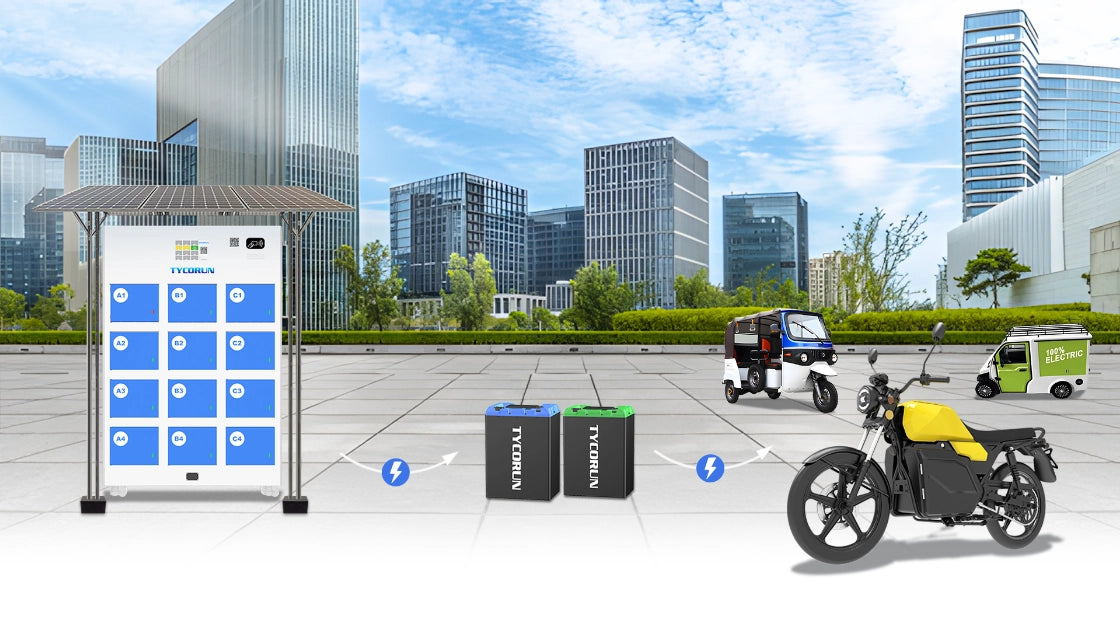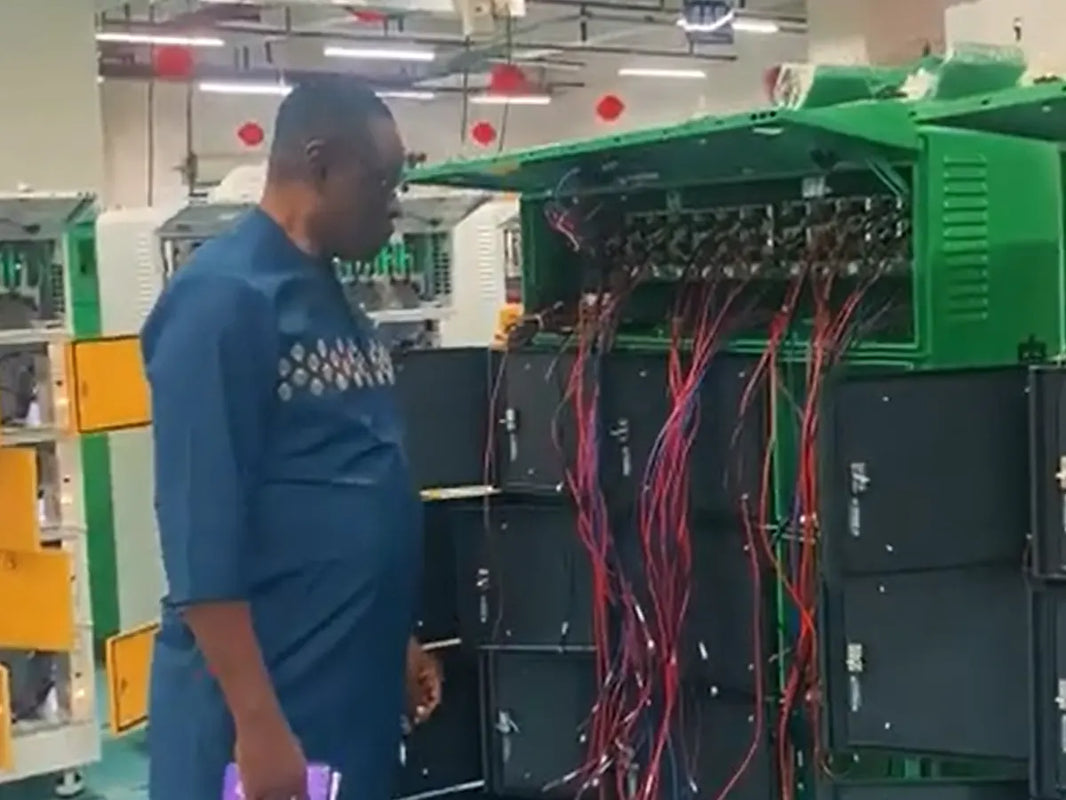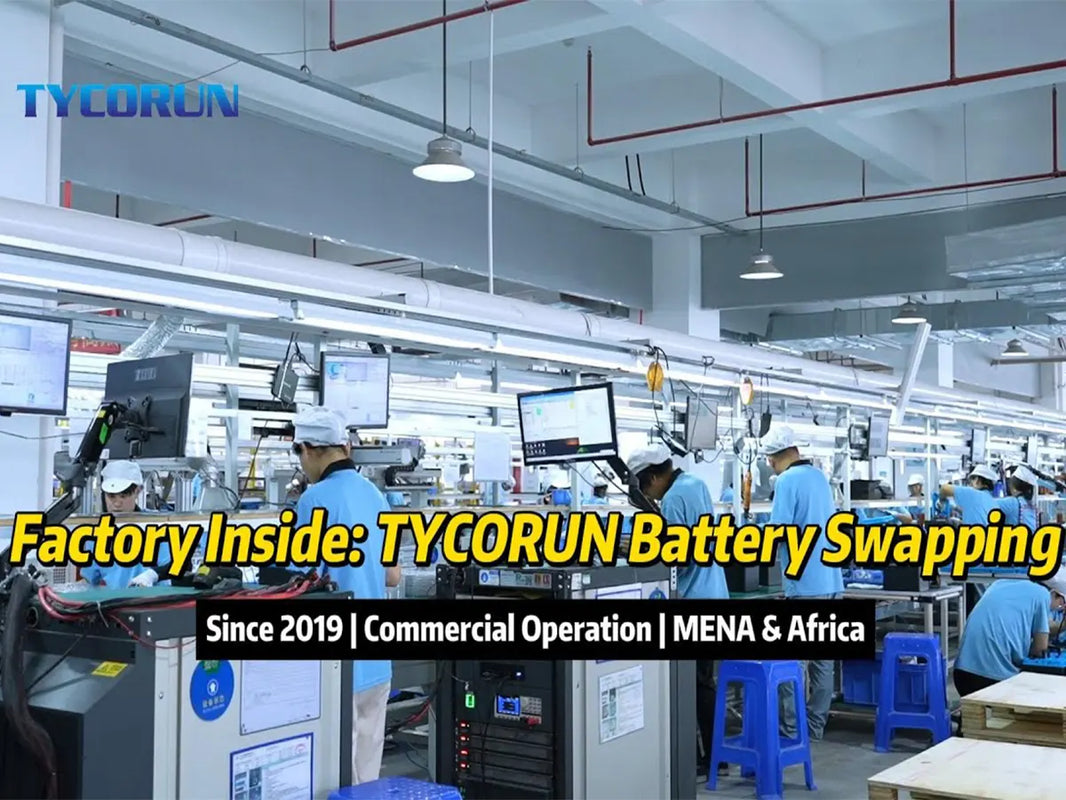In this article, we explain what is battery swapping station and why it’s becoming popular in the EV world. Instead of waiting to charge, drivers can quickly swap empty batteries for fully charged ones in minutes, saving time and reducing downtime. This system is great for electric scooters, motorcycles, and fleet vehicles in busy cities. We’ll cover key features, benefits, costs, and future trends to help you understand how battery swapping stations make electric vehicle use easier and more efficient.

Main content:
- What Is Battery Swapping Station?
- Key Features of a Battery Swapping Station
- Fast Automatic Swapping
- Safety Components
- Intelligent Connectivity Components
- Modular Scalability Components
- Benefits of Using a Battery Swapping Station
- Why Battery Swapping Is Becoming Popular?
- TYCORUN Swap Station Products
- TYCORUN 5-Slot Battery Swap Cabinet
- TYCORUN 8-Slot Battery Swap Cabinet
- TYCORUN 12-Slot Battery Swap Cabinet
- Battery Swapping vs Charging
- How to Choose a Swap Station Manufacturer
- TYCORUN Swap Station Case Studies
- The Future of Battery Swapping Stations
- Conclusion
- FAQs
What Is Battery Swapping Station?
What is battery swapping station? A battery swapping station is a place where people using electric two-wheleer, three-wheeler or even four-wheleer can quickly change their empty battery for a fully charged one. Instead of waiting a long time to charge, riders can swap their battery in just a few seconds. So what is battery swapping station in simple words? It is a fast “battery exchange point” that lets you continue your trip without waiting.
At the station, the user usually verifies their identity with an NFC card, QR code, or a mobile app. After that, a compartment opens, and the rider takes out their empty battery and inserts it into the slot. Then the machine unlocks a fresh, fully charged battery for the user to take.

Key Features of a Battery Swapping Station
Modern battery swapping stations are built with four main abilities: fast automatic swapping, strong safety features, smart connectivity, and easy modular expansion. To make it clearer, let’s use the Tycorun 12-slot battery swapping station as an example and look at the components inside it..
Fast Automatic Swapping
Battery swapping is designed to give riders a fully charged battery in only 40–60 seconds. How fast it works depends on the components and technology inside the station. Here are the key features that make fast swapping possible:
- 15A fast charging for quick battery turnover
- Charging and storage at the same time
- Supports multiple voltage platforms (72V / 60V / 48V)
- NFC fast authentication for quick user verification
- QR code scanning or offline swapping modes
Safety Components
These features keep the battery swapping station safe from fire, overheating, flooding, and other system problems. The station also follows IP (Ingress Protection) standards, which describe how well a device is protected from dust and water.
- Smoke alarm
- High-temperature warning system
- Flood and water-level monitoring
- Aerosol fire extinguisher for fast fire control
- Air-cooling system to prevent overheating
- Optional water-based fire-fighting system
- Sound and light alarm device for quick alerts
Intelligent Connectivity Components
- Cloud Management:
Modern battery swapping stations send important data to the cloud all the time. This includes battery power level (SoC), battery health (SoH), swap history, and any system warnings or faults. The data is uploaded through 4G/5G or IoT networks.
Operators can check everything remotely, fix issues through online diagnostics, update the system with firmware, and create usage reports easily.
- User Interface and Billing System:
The station supports simple ways for users to start battery swapping, such as NFC cards, QR-code scanning, or a mobile app.
The billing system automatically calculates the cost—either per swap or through a subscription plan, rerservation, and offline-swapping. It also sends digital receipts and can connect to fleet or company accounts for easier management.
Modular Scalability Components
It's mean the components that can be expanded, added, or upgraded in modules as the swap station grows:
1. Battery Swap System (modular & expandable)
- Battery swap platform
- Stacker
- Lifting mechanism
- Locking mechanism
- Connectors
2. Power Supply System
- High-voltage cabinet
- Transformer
- Low-voltage cabinet
Benefits of Using a Battery Swapping Station
Battery swapping has many benefits, and understanding them helps explain what is battery swapping station and why it is useful today.
- Minimal Downtime
Swapping a battery takes around 40–60 seconds. Riders don’t need to wait for charging or stand in line. Just swap and continue riding.
- Lower Motorcycle Cost
With Battery-as-a-Service, riders use the motorcycle and rent the battery. This lowers the price because the battery is the most expensive part. Tycorun manages the battery health to keep performance stable.
- Better Energy Use
Tycorun swap stations charge batteries during cheaper off-peak hours and can use solar power. This saves money and supports cleaner energy.
- Smart Monitoring & Easy Expansion
Tycorun stations track battery health and temperature in real time. Operators can start with a small cabinet and add more slots as demand increases.
- Environmentally Friendly
Batteries are used fully, then reused for energy storage or recycled, reducing waste.
- More Convenience
No cables needed—just take out the empty battery and insert a full one. Safety systems check for heat or faults automatically.
- Flexible Plans
Tycorun offers subscription plans or pay-per-swap options for delivery riders, fleets, and everyday users like passenger taxi.
- Works in Low-Power Areas
Tycorun swap stations can run with solar or generator backup, helping riders avoid range anxiety.
In short, Tycorun shows how a battery swapping station makes EV energy fast, simple, and reliable. Understanding these points makes it easier to see what is battery swapping station and why many riders choose it.
Why Battery Swapping Is Becoming Popular?
Many EV users still wonder, “what is battery swapping station and why do we need it?” The answer is simple: it solves the biggest problem of charging, waiting time. Instead of spending hours at a charging station, users can get a fully powered battery in just 40–60 seconds.

Because of this convenience, since around 2018, battery swapping has become popular among delivery food drivers, e-commerce couriers, and ride-hailing services. These platforms use battery swapping technology not only to meet strict delivery time targets and improve speed, but also to make driving easier and more efficient for their drivers.
TYCORUN Swap Station Products
TYCORUN battery swap cabinets feature 4G/Wi-Fi cloud management for real-time monitoring, lightning protection, IP54 water-immersion detection, temperature monitoring with backend alarms, and remote diagnostics. Each cabinet uses a self-developed intelligent system with CAN communication, high-precision sensors, optional battery health checks (requires BMS support), and dynamic power allocation. It supports 15A max charging current per slot, multi-language interface, offline swapping, and multiple swap methods such as scan & swap or reservation also supported battery voltages: 72V / 60V / 48V.
Safety is enhanced with gas-melt fuse protection, 3-color LED slot indicators, fire-safety components, and stable structural design. The cabinet is also customizable in appearance, color, logo, and system configurations. Besides the main TYCORUN swap cabinet specifications above, the following are additional battery swapping station classification that you can customize along with their expanded features:
TYCORUN 5-Slot Battery Swap Cabinet
Specifications of the TYCORUN custom 5 slot battery swap cabinet for 2/3/4 electric wheleer
- Cabinet Size: 400(W) × 515(L) × 1650(H) mm
- Chamber Size: 255(W) × 420(L) × 220(H)
- Number of Slots: 5 battery chambers
- Input Voltage: 220V
- Total Power: 4000W
- Power per Slot: Up to 800W
- Operating Environment: Humidity ≤ 95% RH, temperature −10°C to 55°C
- Weight: 80 kg (without batteries)
TYCORUN 8-Slot Battery Swap Cabinet
Specifications of the custon 8 slot battery swap cabinet for 2/3/4 electric wheleer
- Cabinet Size: 500(W) × 880(L) × 1650(H) mm
- Chamber Size: 240(W) × 420(L) × 220(H)
- Number of Chambers: 8 slots
- Input Voltage: 220V
- Total Power: 6400W
- Max Power per Slot: 800W
- Weight: 154 kg (without battery)
TYCORUN 12-Slot Battery Swap Cabinet
Specifications of the custom 12 Slot battery swap cabinet for 2/3/4 electric wheleer
- Cabinet Size: 600(L) × 1100(W) × 1632(H) mm
- Chamber Size: 220(L) × 240(W) × 420(H) mm
- Number of Slots: 12 battery chambers
- Touch Screen: 10.1-inch display
- Input Voltage: 220V
- Total Power: 9600W
- Power per Slot: 800W
- Max Charging Current per Slot: 15A
- Weight: 235 kg (without batteries)
Battery Swapping vs Charging
Charging piles can work with almost any electric vehicle, but a battery swap station only supports specific battery types, so it is less flexible. Swapping is much faster—usually just a few minutes.

While charging piles take longer because the battery must stay plugged in. However, swapping speed depends on good maintenance and fully charged batteries inside the station.
In terms battery swap vs charging of coverage, charging piles are everywhere, even at homes, while battery swap station locations are still limited to big cities and busy roads.
How to Choose a Swap Station Manufacturer
Choosing the right battery swapping station manufacturer is important for long-term performance and ROI. Here is a quick guide:
1. Check Technical Strength
Pick a manufacturer with strong R&D, good BMS design, and reliable hardware/software development.
2. Look at Product Options
Make sure they offer different cabinet sizes and allow easy expansion as your fleet grows.
3. Review Manufacturing Quality
Choose brands with certified factories (ISO, CE, IP ratings) and proven quality control.
4. Focus on Safety Features
The station should include temperature monitoring, smoke detection, alarms, and automatic protection.
5. Evaluate the Software Platform
A good cloud system shows battery health, swap history, and supports API integration with apps and payment systems.
6. Check After-Sales Service
Confirm they provide fast local support, training, and easy access to spare parts.
7. Compare Cost and Financing Options
Look at total cost (hardware + cloud + installation) and whether they offer battery leasing (BaaS).
8. Ask for Case Studies
A reliable manufacturer should have real deployments and customer references.
9. Ensure Future-Proofing
Choose a brand that can upgrade to new technologies like 5G, better IoT boards, or new battery types.
TYCORUN Swap Station Case Studies

TYCORUN is a globally recognized battery swapping manufacturer operating in more than 48+ countries across China, Africa, and Asia. With a strong reputation and reliable technology, TYCORUN has become a trusted partner for many companies seeking efficient EV energy solutions. One of its latest success stories is the partnership with Atom-Moto, a leading brand based in Johannesburg, South Africa, which supports Takealot, the number-one e-commerce delivery platform in Africa.
To meet Atom-Moto’s growing demand, TYCORUN provided a complete battery swapping ecosystem. This includes 44 units of 12-slot smart battery swap cabinets, 1,250 sets of 73V 45Ah semi-solid-state lithium batteries and 626 units of 4.5kW electric motorcycles, each using two swappable 73V 45Ah batteries. With this setup, Atom-Moto can operate smoothly as a vehicle rental platform, giving riders quick access to charged batteries, reducing downtime, and improving overall delivery efficiency.
The Future of Battery Swapping Stations
Key Trends and Predictions (2026–2030)
1. Fast Market Growth:
The global EV battery swapping market is expected to reach about $5.93 billion by 2030. It will grow very quickly, with a yearly growth rate of 25–30% starting from 2025.
2. Asia-Pacific Leading the Market:
Countries like China and India will stay in front because they have many scooters and three-wheelers, plus strong government support.
3. Focus on 2-Wheelers and 3-Wheelers:
Most battery swapping stations will serve motorcycles, scooters, and autorickshaws. Commercial EVs used for delivery and ride-sharing will also grow fast.
4. More Swap Stations Being Built:
Big companies are planning huge expansion:
- CATL: 2,500 stations by 2026 and 10,000 in the future
- SUN Mobility + Indian Oil: Planning 10,000 stations in India by 2030
- Nio and other brands are also expanding quickly.
5. Standardized Batteries Coming:
The industry will move toward common battery shapes and connectors, such as CATL’s “Choco-Swap” design. This allows different EV brands to use the same swap stations, which will help more people adopt battery swapping.
Innovations and Growth Drivers
- Government Support:
Many countries—especially China, India, and Indonesia—are offering tax cuts, incentives, and funding to speed up battery swapping development.
Read: Top battery swap company in Indonesia
- Better Battery Technology:
New battery types like LFP and solid-state will make swappable batteries safer, lighter, and longer-lasting. Automated swap stations will also become more common.
- Energy and Grid Benefits:
Swap stations will also help power companies by storing extra energy and supporting solar or other renewable energy sources. This improves energy efficiency and stability for the whole system.
Conclusion
Now you clearly understand what is battery swapping station and why this system is becoming a key part of the EV revolution. It provides fast and convenient energy for 2-wheeler, 3-wheeler, and even 4-wheeler electric vehicles. With features like smart management, high safety, low cost, and 24/7 availability, battery swapping works well for both beginners and experienced riders.
As more people search for what is battery swapping station, it’s clear that this technology is shaping smarter and more efficient transportation. Beyond convenience for commuters, delivery riders, and everyday EV users, battery swapping also presents opportunities for businesses and brands in the EV ecosystem. Partnering with a reliable provider can improve efficiency, reduce downtime, and expand services, while fast, safe, and scalable systems help ensure long-term growth and operational flexibility.
FAQs
How safe is the swapping process?
Very safe. Tycorun cabinets have multiple sensors, fire protection, and monitoring systems to keep users and batteries secure.
Do I need to own the battery?
Not necessarily. Many Tycorun partners offer battery rental or subscription services, so you don't have to buy the battery upfront.
Is battery swapping faster than charging?
Yes, battery swapping is much faster than charging. While charging can take 30 minutes to several hours, a swap takes only seconds, letting riders get back on the road almost instantly.
How does the battery swap system work?
Smart battery swap cabinet lets users quickly exchange a depleted battery for a fully charged one via the app, completing the swap in as fast as 12 seconds.
What are the uses of battery swapping?
Battery swapping is currently popular as a solution in the delivery sector, such as: Food delivery, e-commerce platforms, passenger taxi, and logistics.
Related Articles: Battery swapping station cost, Battery swapping stations business model, Battery swap station customization
















